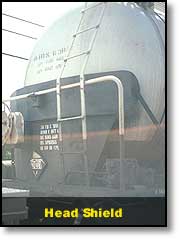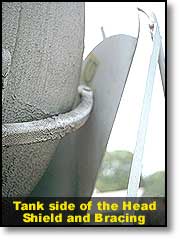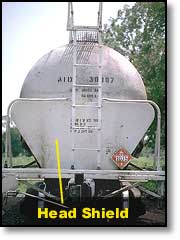 Head Shield (If Applicable)
The head shield is a supplemental heavy steel plate required by AAR regulations on the ends of some hazardous commodity tank cars. Head shields lessen the chance of tank head puncture by the coupler of any adjacent car in the event of excessive end impact or derailment. Head shields can be either "full" (cover the entire end of tank head) or "partial" (cover only the lower portion of the tank head, as shown here). Head Shield (If Applicable)
The head shield is a supplemental heavy steel plate required by AAR regulations on the ends of some hazardous commodity tank cars. Head shields lessen the chance of tank head puncture by the coupler of any adjacent car in the event of excessive end impact or derailment. Head shields can be either "full" (cover the entire end of tank head) or "partial" (cover only the lower portion of the tank head, as shown here).
If the head shield can be viewed, inspect all supports and bracing for crack welds and broken braces.
Most tank cars that have head shields use full or partial head shields which are welded to the head of the tank. If the tank car is jacketed, then you will not be able to see the head shield.
Some chemical companies make the heads of their tank cars 1-1/2 times the shell thickness. This procedure reduces the chance of a head puncture caused by a coupler in a train wreck. It can be done on tank cars that do not require a head shield, but does not eliminate the need for head shield on tank cars which require one.
Tank cars of the 105, 112, 113, and 114 classes and with the letter indications of "S", "J", and "T" will be equipped with head shields.
"S" Definition: Describes a tank car equipped with a DOT approved head shield as specified in parts of 49 CFR 179.100 and 49 CFR 179.105-5 of the DOT tank car regulations. This tank car does not require thermal insulation.
.jpg) "J" Definition: Describes a tank car equipped with a thermal protection system and a safety relief valve with a defined minimum discharge capacity (as specified in part of 49 CFR 179.105-5 of the DOT regulations). "J" defines that the thermal protection system is covered with a steel jacket. All tank cars with the "J" designation are required to have head protection as defined above for the "S" designated tank cars. "J" Definition: Describes a tank car equipped with a thermal protection system and a safety relief valve with a defined minimum discharge capacity (as specified in part of 49 CFR 179.105-5 of the DOT regulations). "J" defines that the thermal protection system is covered with a steel jacket. All tank cars with the "J" designation are required to have head protection as defined above for the "S" designated tank cars.
"T" Definition: Describes a tank car equipped with a thermal protection system and a safety relief valve as described for the "J" designation above. The "T" designation also denotes a spray-on or rolled-on thermal protection system that is applied directly to the exterior of the tank. The material hardens and provides its own protective shell, and a steel jacket is not required.
|
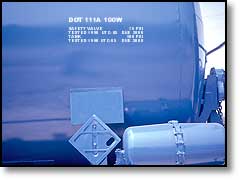
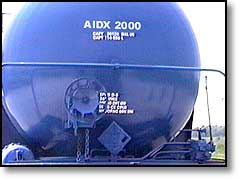
 Head Shield (If Applicable)
Head Shield (If Applicable).jpg) "J" Definition: Describes a tank car equipped with a thermal protection system and a safety relief valve with a defined minimum discharge capacity (as specified in part of 49 CFR 179.105-5 of the DOT regulations). "J" defines that the thermal protection system is covered with a steel jacket. All tank cars with the "J" designation are required to have head protection as defined above for the "S" designated tank cars.
"J" Definition: Describes a tank car equipped with a thermal protection system and a safety relief valve with a defined minimum discharge capacity (as specified in part of 49 CFR 179.105-5 of the DOT regulations). "J" defines that the thermal protection system is covered with a steel jacket. All tank cars with the "J" designation are required to have head protection as defined above for the "S" designated tank cars.